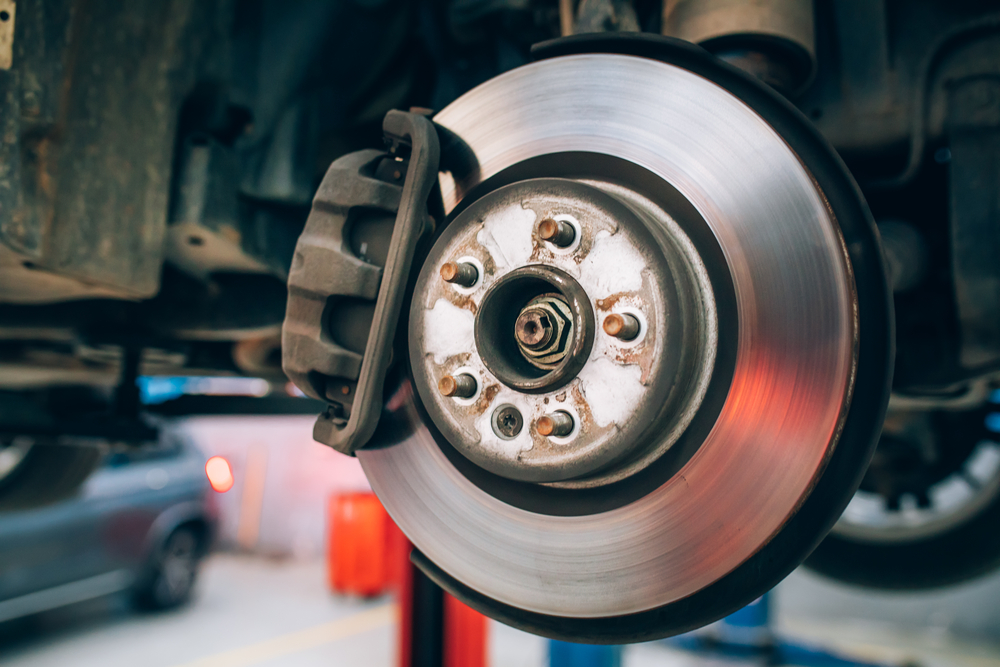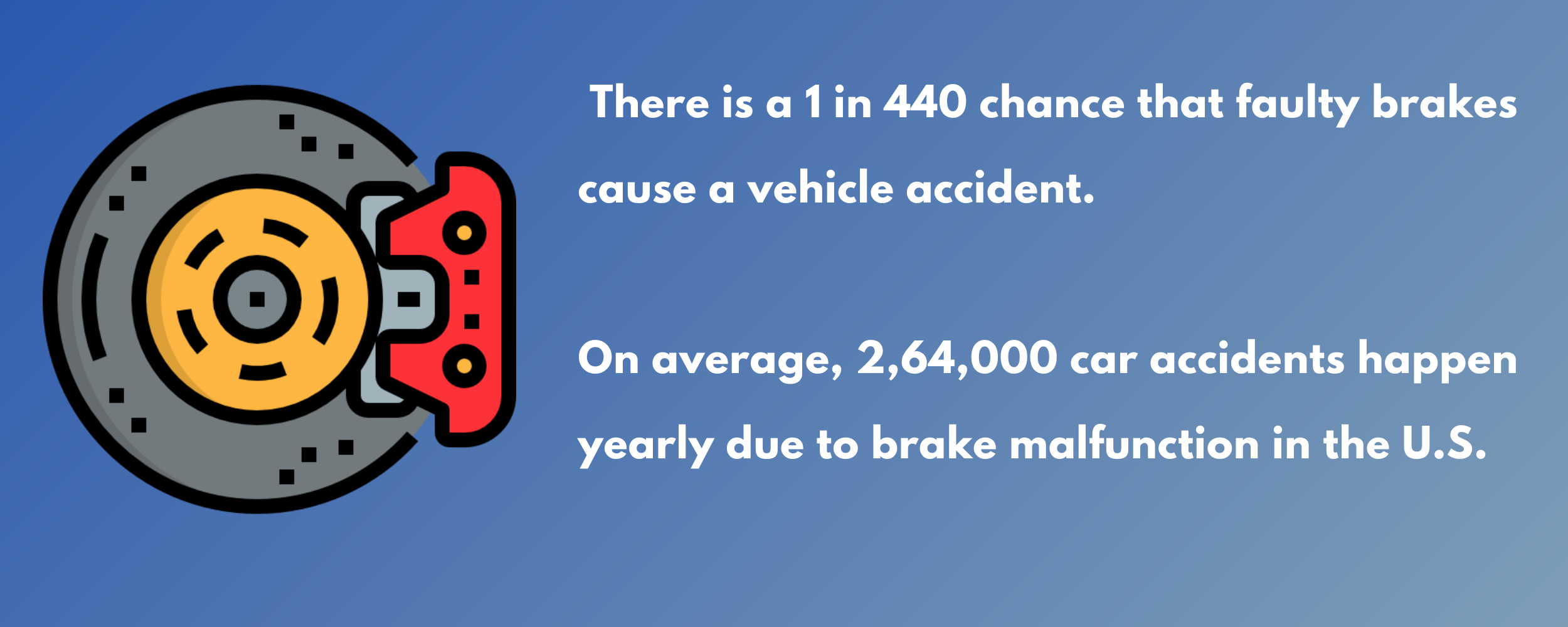
It is impossible to overstate the importance of brakes. The ability to slow a car down and bring it to a stop is fundamental to driving. Brakes perform this critical function countless times, even on the shortest journey. In emergencies, they can prevent accidents and save lives. Thanks to advances in technology and manufacturing, brake failure is rare. However, when it does happen, the effects can be devastating. Read on to discover all you need to know about the risk of brake failure, the warning signs, and what to do if your brakes fail.
Key Brake Failure Statistics You Can't Ignore
- Brake failure accounts for 0.44% of all passenger car accidents in the United States.
- There is a 1 in 400 chance of a vehicle accident caused by brake malfunction or failure.
- On average, 2,64,000 car accidents happen yearly due to brake malfunction in the U.S.
- Approximately 2% of all vehicle crashes in the United States are due to a critical vehicle defect. Of this 2%, 22% of crashes are attributed to a brake malfunction.
- In 2022, brake-related recalls accounted for 6% of the total vehicle recalls. The NHSTA issued 57 recalls due to brake-related issues, affecting 1.7 million vehicles that year.
- Brake failure is 1.4 times more likely during the summer. This increased risk can be attributed to excessive heat, which accelerates the degradation of the brakes.
- A 2022 study, which analyzed ten years (2010-2019) of crash data in Wyoming, concluded that vehicles older than 15 years were 1.8 times more likely than newer vehicles to be involved in a brake failure crash resulting in injuries or death.
- The Wyoming study highlights that the odds of brake failure-related collisions resulting in fatalities and injuries are significantly higher for trucks (6.9 times more likely) than for other vehicle types (1.5 times more likely for SUVs and pickups, for example).
- On average, Honda advises that brake pads should be replaced every 25,000 to 65,000 miles while rotors should be changed anywhere from 30,000 to 70,000 miles.
- The cost of replacing brake pads and rotors can vary between $250 and $678 per axle, according to estimates compiled by Nubrakes.
- RepairSmith advises that the minimum thickness for brake pads is 3.2 mm (⅛ inch). Drivers should check brake pad thickness every five months or 5,000 miles.
- Brake fluid absorbs moisture as it ages. Automotive oil and lubricant company, Castrol, reports that as little as 3.5% water can reduce brake fluid effectiveness by up to 40%. It recommends changing brake fluid at least every two years.
- The top three most common causes of brake failure are brake fluid leakage, a faulty brake master cylinder, and a defective brake booster, according to Custom Complete Automotive.

HOW COMMON IS BRAKE FAILURE?
The rate of brake failure depends on the vehicle type. It is a rare occurrence in passenger cars, accounting for 0.44% of all passenger vehicle crashes in the United States. There are an estimated 6 million road traffic accidents every year, so brake malfunction is responsible for approximately 2,64,000 collisions. As a whole, faulty vehicles contribute to 2% of vehicle crashes. Brake failure is the second most common cause of all vehicle-related accidents, responsible for 22% of crashes. Tires are the top cause, responsible for 35%.
In summary, there is a 1 in 440 chance that a vehicle accident is caused by faulty brakes.
Trucks carry a much higher risk of brake failure, with 30% of crashes due in some part to faulty or deficient brakes. Heavy loads, excess speed, and overuse of the brakes cause severe damage to the braking system. This degradation happens most on downhill roads. An experienced heavy goods driver knows to shift down gears and drive at a slower speed downhill instead of using brakes excessively. Engaging the brakes for long periods, together with a heavy load, will cause overheating and brake failure.
WHAT TO DO WHEN BRAKES FAIL
If your brakes stop working, the most important thing is to remain calm and not panic. Sudden maneuvers can increase the likelihood of an accident.
Instead, follow the below steps to bring the car to a rolling stop:
- Take your foot off the accelerator.
- Turn on your hazard lights to alert other drivers to give you space. Honk the horn if needed.
- Move the car into a lower gear to help reduce the speed.
- If the car has an anti-locking braking system (ABS), put your foot down on the brake pedal fully. Otherwise, try pumping the pedal as fast as possible to engage the front or rear braking system.
- Pull over onto the side of the road in a controlled manner.
- When at a low speed, try pulling gradually on the parking brake. Alternatively, as a last resort (and if there is plenty of space around the car), switch off the engine.
- Once the car is stationary, exit the vehicle safely and call roadside assistance.
SIGNS OF POTENTIAL BRAKE PROBLEMS
The good news is that there are usually some warning signs that the brakes need attention. The key indicators are:
- The brake light warning on the dashboard is illuminated.
- The brakes feel soft or spongy.
- The vehicle pulls to one side when braking.
- There is a metallic grinding or squealing noise when braking.
- There is brake fluid leaking under the vehicle.
- There is a burning smell or smoke when driving.
- The steering wheel shakes when braking.
If your car experiences any of these characteristics, you should take it to a garage for inspection without delay.
Conclusion
Advances in technology have reduced the possibility of brake failure. However, owner negligence, aggressive driving habits, faulty servicing, or faulty installation increase the risk of being left without braking power. For the best possible outcome, it is sensible for drivers to familiarize themselves with the emergency procedure for brake malfunction.
Keeping a regular schedule of inspections and maintenance, and being vigilant for any slight changes in brake function in the interim, will ensure that brake failure remains a rarity.
Sources:
- https://crashstats.nhtsa.dot.gov/Api/Public/Publication/812115
- https://datahub.transportation.gov/stories/s/NHTSA-Recalls-by-Manufacturer/38mw-dp8u/
- https://www.sciencedirect.com/science/article/pii/S0022437522001566#b0045
- https://www.hondaoflincoln.com/service/service-tips/how-long-do-car-brakes-last/
- https://nubrakes.com/blog/can-you-replace-brake-pads-without-replacing-rotors/
- https://www.repairsmith.com/blog/brake-pad-thickness/
- https://www.castrol.com/en_gb/united-kingdom/home/car-engine-oil-and-fluids/brake-fluids.html
- https://www.customcompleteautomotive.com/3-causes-of-brake-failure-and-when-to-seek-repair/
- https://nubrakes.com/blog/7-signs-of-unsafe-brakes/
